

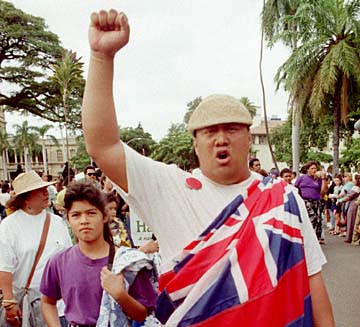
Hawaii for the Ages
Highlights of our islands' evolution
Some 10 million years ago: Waianae volcano breaks Pacific Ocean surface; lava from three sets of cracks eventually meets to form central vent near today's Kolekole Pass.
A few million years later: Koolau volcano emerges as an isle a few miles east of Waianae mount. The two volcanoes continue building, gradually filling in to create Oahu.
About 1600-1200 B.C.: A cultural complex called Lapita, named after a New Caledonia site, spreads eastward from New Guinea to Fiji, Samoa and Tonga. Polynesian culture develops at eastern edge of this area (Samoa and Tonga).

About 300-500 A.D.: Polynesians from the South Pacific, likely the Marquesas Islands, begin migrating to Hawaii in double-hulled canoes. This first migratory wave comes via the Samoan and Society Islands, led by chief Nanaula, according to later writings by King David Kalakaua. Other chiefs also come with families, either from Tahiti or Samoa.
About 1000: Adventurers arrive under warlike chief Nanamaoa, probably from the Society Islands, who establishes power bases on Hawaii, Maui and Oahu.
1095-1300: Society Islands adventurers are soon followed by Tahitian explorers, who begin a long, second immigration wave. This begins over 200 years of voyages between Hawaii and Tahiti, a 2,500-mile route; they subdue and enslave the more primitive inhabitants.
1095-1120: Among South Pacific immigrants is high priest Paao, who sends for Pilikaeae, chief from his homeland. Pilikaeae becomes sovereign of the Big Island and begins a dynastic line there. Centuries later, Kamehameha I would descend from this dynasty.
End of 12th century: All communications between Hawaiian and South Pacific island groups cease. One theory, say later writings by King Kalakaua: possible disappearance of isle landmarks to guide voyaging mariners. (Some date the halt of Tahiti-Hawaii voyaging closer to 1275.)
In 13th century: Shipwrecked Japanese sailors are said to have landed in Maui.
1400: A distinct Hawaiian culture begins to emerge as social classes are created and islanders split into tribes; adornments include feathered capes, helmets and jewelry made of shells and teeth.
1400-1600: Various island kings -- notably Kiha, Liloa, Umi and Lono -- rule over fiefdoms which include systems of tabu, religion, government, arts and customs. This is era of interisland wars.
1555: Spaniard Juan Gaetano reports finding a group of isles, at same latitude as Hawaii, which he calls "Islas de Mesa" or "Los Majos." But he mis-records the longitude -- and Hawaii remains isolated from the Western world.
1754-1782: Kalaniopuu rules the 23rd regime in the Hawaii Island sovereign line; his nephew and successor, Kamehameha, would soon unify the Hawaiian islands.
1775-1779: Years of war between Kalaniopuu, Big Island moi (king), and Kahekili, Maui's moi.
About 1758: Kamehameha the Great is born on the Kohala Coast. Old Hawaiian astronomers say a brilliant star appeared that year (perhaps the 1758 return of Halley's Comet).
Jan. 18, 1778: Capt. James Cook, British naval commander, sees Oahu and Kauai while seeking northern sea passage from Pacific to Atlantic. He names his find the "Sandwich Islands." At first, Hawaiians treat Cook as a god, identifying him with Lono, god of the elements.
January 1779: Cook and his ships arrive at Kealakekua Bay, Big Island. On Feb. 13, he and others are slain by Hawaiians over theft of a boat from the HMS Discovery and tensions between natives and foreigners.
1782: Kamehameha begins a campaign to unify the Hawaiian isles. In a decisive battle with his cousin Chief Kiwalao on the Big Island's west coast, Kiwalao is slain.
1794: Maui's Kahekili, ruler of all isles except Big Island, dies; Kamehameha overtakes holdings.
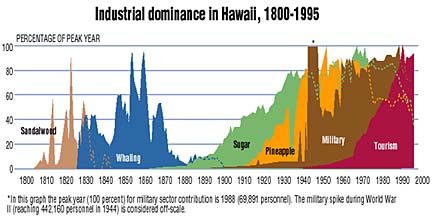
1809: Russian governor of Alaska indicates interest in Hawaii: A fort is built, the imperial flag raised, and negotiations to lease Kauai begin but are not consummated.
1804: Great sickness, mai okuu, probably bubonic plague or cholera, kills some 150,000 Hawaiians, nearly half of the population.
1810: Kauai king Kaumualii cedes his island to Kamehameha; Kingdom of Hawaii born.
1816: Hawaiian flag designed by Capt. George Beckley.
1819: Kamehameha dies, succeeded by son Liholiho (Kamehameha II). Kapu system overthrown. Also: First New England whaling ship harpoons whales in Hawaiian waters.
1820: First Protestant missionaries arrive on brig Thaddeus; Kawaiahao Church founded with the Rev. Hiram Bingham as pastor.
1824: In England, Liholiho and Queen Kamamalu die of measles.
1825: Kauikeaouli, 11, is Kamehameha III. Also: First sugar and coffee plantations, in Manoa, started by John Wilkinson. Also: Kaahumanu and Kalanimoku accept Christianity.
1826: Capt. James Hunnewell trades sandalwood with China; precursor to C. Brewer & Co. ALSO: First U.S. naval vessel comes here.
1830: Mexican and Californian cowboys (paniolos) arrive on Big Island for cattle business. Also: Sandalwood trees depleted.
1835: First sugar plantation at Koloa, Kauai, by Ladd & Co. on leased land, using native laborers.
1836: First English newspaper west of Rockies, the Sandwich Island Gazette. Also: Treaty negotiated between Sandwich Islands and Great Britain.
1837: Hilo tidal wave kills 14.
1839: Kamehameha III enacts Bill of Rights.
1840: First Hawaiian Constitution; king shares power with legislature.
1841: Punahou School opens for missionary children.
1842: Kingdom of Hawaii recognized by United States.
1843: British naval Capt. George Paulet seizes Hawaiian kingdom in February; in July, British Adm. Richard Thomas restores Hawaiian flag at what is now Thomas Square. Kamehameha III, in restoration-day speech, recites phrase that becomes Hawaii's motto: Ua mau ke ea o ka aina i ka pono ("the life of the land is perpetuated in righteousness").
1848: Great Mahele, or "Division of Lands," made by Kamehameha III, creates fee-simple land ownership among king, chiefs and commoners. ALSO: Epidemic of measles, whooping cough, flu kills thousands.
1849: Capt. H. Hackfeld opens store that becomes American Factors (Amfac).
1850: Treaty with United States ratified; Honolulu declared Hawaii's capital. Also: Legislature OKs contract labor system to recruit foreigners for plantations. Also: Mormon mission arrives.
1851: Castle & Cooke formed.

1852: Chinese laborers arrive.
1854: Kamehameha III dies, suceeded by nephew Alexander Liholiho (Kamehameha IV). ALSO: Legislature passes law promoting English in the schools.
1859: Gas lights introduced. Also: Queen's Hospital opens.
1863: Kamehameha IV dies, succeeded by brother Lot (Kamehameha V). Also: C. Brewer is first sugar plantation agent.
1864: Kamehameha V sells Niihau to Elizabeth Sinclair for $10,000.
1866: First monthly steamer service from California. Also: Hansen's disease patients exiled to Kalaupapa, Molokai.
1868: Big Island quake causes Hilo tsunami; 79 people killed.
1870: Alexander & Baldwin founded.
1872: Kamehameha V dies; Lunalilo elected in 1873.
1873: Father Damien goes to Kalaupapa.
1874: Lunalilo dies; riot ensues when Legislature votes between Queen Emma and Kalakaua. Kalakaua, elected king, is first Hawaii monarch to visit United States; he pens "Hawaii Pono'i."
1877: Big Isle tsunami kills five, causes $14,000 damage.
1878: First phones, on Maui. Also: Portuguese workers arrive.
1878: Liliuokalani pens "Aloha 'Oe."
1879: James Campbell drills first artesian well, on Oahu.
1880: Kalakaua revives the hula. Also: Hawaiian Bell Telephone Co. established.
1881: Norwegian and German laborers arrive.
1883: Coronation of King Kalakaua and Queen Kapiolani marks ninth year of their reign. Also: Kamehameha statue erected in front of Hale Aliiolani.
1884: First trade union forms. ALSO: Japanese immigrants arrive, followed next year by 1,400 more.
1885: Princess Pauahi Bishop dies, leaving lands to endow Kamehameha Schools, founded two years later. Bishop Museum founded in 1889.
1886: Great Honolulu fire.
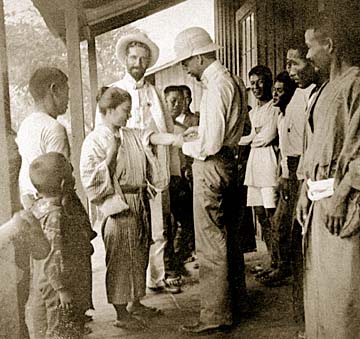
1887: Kalakaua forced to sign "Bayonet Constitution," which limits monarch's powers.
1888: B.F. Dillingham starts Oahu railway.
1890: Electricity arrives.
1891: Kalakaua dies, succeeded by sister, Liliuokalani.
1893: Liliuokalani -- and Kingdom of Hawaii -- overthrown. Provisional government, under President Sanford Dole, is proclaimed.
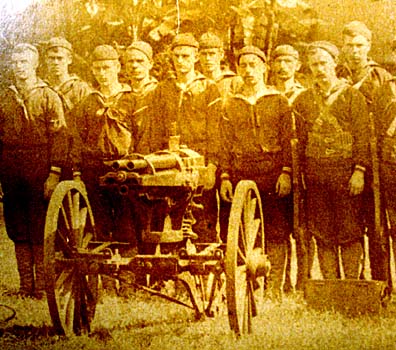
1894: Provisional government becomes Republic of Hawaii.
1895: Hawaiian Sugar Planters Association formed. Also: Robert Wilcox leads failed coup to restore monarchy.
1898: In July, President William McKinley signs congressional resolution annexing Hawaii to United States. Also: Spain declares war on United States in April, and Hawaii assumes strategic importance as military hub. First federal garrison troops set up temporary post, Camp McKinley near Diamond Head.
1900: On June 14, President McKinley signs Organic Act forming Territory of Hawaii -- all U.S. laws now enforced by territorial government headed by Gov. Sanford Dole. Also: A January fire, set to purify Chinatown of bubonic plague, goes out of control and destroys 38 acres; thousands lose homes and businesses.
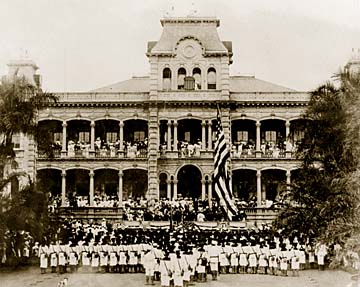
1902: Prince Jonah Kuhio Kalanianaole chosen U.S. Congress delegate. Also: Trans-Pacific cable completed.
1907: Fort Shafter becomes territory's first permanent military post. Also: College of Agriculture and Mechanic Arts, predecessor of University of Hawaii, opens at Thomas Square. Also: Walter Frear named governor.
1908: City and County of Honolulu formed; Joseph J. Fern is first mayor. Also: Pearl Harbor construction is authorized.
1910: First airplane flight in Hawaii, at Moanalua Polo Field.
1912: Duke Kahanamoku wins gold medal in 100-meter swim at Olympics Games in Sweden; in 1920 he wins 100-meter freestyle at Olympic Games in Antwerp. Also: Outdoor Circle formed.
1913: Library of Hawaii opensdowntown. Also: Lucius E. Pinkham is governor. Also: First Hollywood films made here: "The Shark God" and "Hawaiian Love."
1914: Honolulu Zoo opens.
1915: Bus service inaugurated by Honolulu Rapid Transit Co.
1916: Waiahole Tunnel opens, taking Windward water to Central Oahu fields. ALSO: Hawaii National Park created; in 1961 it's renamed Hawaii Volcanoes National Park.
1917: Queen Liliuokalani dies at Washington Place.
1918: Charles J. McCarthy is governor. Also: First interisland flight, from Molokai to Oahu. Also: WWI mobilizes Hawaii National Guard in June to protect isles after most of Army dispatched to France; eight German ships in harbor seized. End of WWI celebrated here at Nov. 11 Victory Parade.
1921: Reclamation of Waikiki swampland begins. Also: Wallace R. Farrington is sixth governor.
1922: U.S. Congress enacts Hawaiian Homes Commission Act on July 9, providing for homesteading by native Hawaiians. ALSO: Jonah Kuhio Kalanianaole, delegate to Congress since 1902, dies. ALSO: Hawaiian Pineapple Co. buys Lanai to supply fruit for its Honolulu cannery and introduces large-scale planting, canning and shipping. ALSO: Hawaii Theatre and Federal Building open in Honolulu.
1923: Territorial Legislature enacts "Hawaii's Bill of Rights" to get same treatment given to states; Congress passes it in 1924.
1924: Eight-month Kauai plantation strike results in deaths of four policemen and 16 strikers.
1925: First flight attempt between Hawaii and mainland leaves near San Francisco on Aug. 31, but the two-engine Navy seaplane with John Rodgers and four others aboard runs out of fuel 300 miles from Hawaii; they are rescued Sept. 10 off Nawiliwili, Kauai.
1926: Aloha Tower is dedicated. ALSO: Sanford Dole dies.
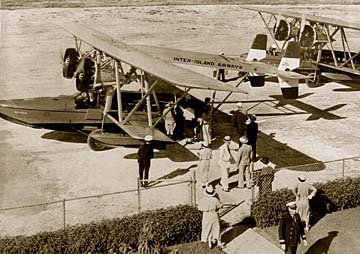
1927: Royal Hawaiian Hotel opens in Waikiki. Also: In March, John Rodgers Airport is dedicated; it later is Honolulu International Airport. Also: In June, Army lieutenants make first successful nonstop flight from mainland to Hawaii aboard "Bird of Paradise." Also: In August, 10 die in air derby between Oakland to Hawaii, billed as "first transoceanic flight race in history."
1929: Inter-Island Airways Ltd., forerunner to Hawaiian Airlines, begins commercial passenger service.
1931: Notorious "Massie Case" makes national headlines, in which Thalia Massie claimed rape by five "local boys." Also: In November, Mutual Telephone Co. starts interisland radio phone service; weeks later, mainland service begins.
1935: Amelia Earhart makes first solo flight between Hawaii and mainland. Also: First airmail flight between Hawaii and West Coast, by Pan American Airway's "China Clipper." Also: First public pay phones.
1938: Inter-Island Steamship Co. docks shutdown after two years of sporadic strikes; dozens hospitalized in related violence.
1939: In May, Honolulu's first blackout drill lasts 20 minutes. In August, FBI's Honolulu office reopens to work with Army, Navy on possible spying incidents.
1940: In April, 130 U.S. Fleet ships arrive. On May 23, entire territory does blackout drill. In August, fingerprinting of aliens begins under federal Alien Registration Act. Also: Navy plans for its largest Pacific air base, on 2,700 acres at Barbers Point, plus expanding Kaneohe NAS at Mokapu Peninsula. Defense workers arrive for Pearl Harbor and Midway. ALSO: General election plebiscite favors statehood by 2-1 margin.
Spring 1941: Buildup of U.S. military power here includes May arrival of 21 Flying Fortresses. In June, Army plans $750,000 food storage tunnel near Fort Shafter.
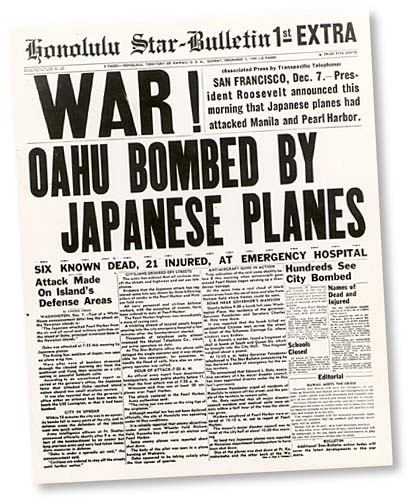
Dec. 7, 1941: Japan's attack on Pearl Harbor plunges United States into World War II. The USS Arizona and other ships are sunk; more than 2,500 lives are lost. Martial law in Hawaii is declared. On Dec. 8, schools are taken over for evacuation centers, hospitals and defense purposes.
On Dec. 18, U.S. military orders farmers near West Loch evacuated; next day, all residents evacuated from Iwilei.
Also: On Sept. 1, some 8,000 unionists march in Labor Day parade, largest labor gathering in territory's history.
1942: On Jan. 28, Army transport Royal T. Frank torpedoed by Japanese sub between Hawaii and Maui, killing dozens. In February, President Franklin D. Roosevelt signs Executive Order 9066, ordering people of Japanese descent be moved from California, Washington, Oregon. Some 112,000 ousted from homes, businesses. In June, Adm. Chester Nimitz announces win at Battle of Midway. Also in summer: 1,300 Japanese-American volunteers leave for Camp McCoy, Wis., to train as 100th Infantry Battalion; nine months later, this "Purple Heart Battalion" merges with 442nd Regimental Combat Team. In August, Ingram Stainback appointed governor. On Nov. 23, first 107 Hawaii Japanese at Jerome Relocation Center, Ark.
1943: On March 28, 15,000 attend program for 2,600 AJA volunteer Army soldiers leaving for Camp Shelby, Miss. In September the 100th Battalion begins action in Italy.
1944: On May 21, explosion of LSTs in Pearl Harbor kills 127, injures 380. In May-June, troops leave here for Saipan, Tinian and Guam. In July, President Roosevelt holds military conference here. On Oct. 24, martial law here formally ends. Also in October: 442nd Regimental Combat Team liberates French towns of Bruyeres and Biffontaine from Nazis, rescues "Lost Battalion."
Also: On July 19, Democratic National Convention endorses statehood for Hawaii.
1945: In January, troops leave here for Iwo Jima and Okinawa; CINCPAC moves from Pearl Harbor to Guam. May 8 brings end of hostilities in Europe. Curfew here is lifted July 7, but Pacific war rages until August. On Aug. 6, U.S. drops atomic bomb on Hiroshima, instantly killing at least 70,000; another a-bomb hits Nagasaki Aug. 9. On Aug. 14, Japan surrenders, ending gas rations, labor controls, censorship here.
On Sept. 2, Japanese sign surrender papers aboard the USS Missouri in Tokyo Bay. On Nov. 14, first large group of Hawaii AJA internees, 450 total, return.
ALSO: On Aug. 3, first negotiated labor contract in agriculture, between sugar growers and ILWU. ALSO: On Dec. 22, U.S. Secretary of Interior Harold Ickes officially recommends statehood for Hawaii, based on its outstanding WWII record.
1946: On Jan. 7, 11 years after initial meetings here, subcommittee of U.S. Committee on Territories holds hearings, recommends legislation be considered to admit Hawaii as state. But U.S. Senate would oppose it for a decade. Also: On April 1, Hilo tsunami kills 159, injures some 160, causes $25 million damage. ALSO: In July, Trans Pacific Airlines founded; becomes Aloha Airlines in 1958.
1948: President Harry S Truman endorses Hawaii statehood bill in February report to Congress. ALSO: Tripler Army Hospital opens.
1949: National Memorial Cemetery at Punchbowl opens. ALSO: Six-month dock strike, led by Jack Hall and ILWU, freezes community.


1950: In effort to gain statehood, Hawaii Constitutional Convention convenes April 4. ALSO: On April 19 in Iolani Palace, U.S. House Committee on Un-American Activities holds hearings on alleged communist influence in Hawaii labor groups; 39 of 68 witnesses called refuse to testify on constitutional grounds.
1951: Oren E. Long is 10th territorial governor. ALSO: Temple Emmanu-El built. ALSO: Oahu Federation of Teachers organizes.
1952: First scheduled TV broadcast here, by KGMB. ALSO: Tsunami from quake off Kamchatka causes damage here.
1953: ILWU's Jack Hall and six others convicted June 16 under anti-communist Smith Act; convictions later overturned by federal appeals court. ALSO: Japan's Crown Prince Akihito visits Hawaii. ALSO: Samuel Wilder King is 11th territorial governor.
1954: U.S. Senate committee approves statehood bill for Hawaii despite former Gov. Ingram Stainback's testimony that labor unions here are infiltrated by communists.
1955: Brigham Young University-Hawaii and Chaminade University founded.
1956: Waikiki Shell opens.
1957: 12th Territorial Gov. William F. Quinn appointed. ALSO: Pali Highway's first two tunnels open to traffic. ALSO: Tsunami from Aleutian Islands earthquake causes $5 million in damage here. ALSO: CINCPAC on Oahu becomes command central for U.S. Pacific armed forces, world's largest single unified military command.
1958: Containerized cargo shipments begin on Matson freighters. ALSO: Trans Pacific Airlines becomes Aloha Airlines.
1959: Hawaii officially becomes 50th U.S. state on Aug. 21: U.S. Senate approval occurs March 11, then the House on March 12, then signing of the law by President Dwight D. Eisenhower on March 18; a plebiscite of residents OK it in June. In Hawaii's first general election on July 28, Republican William F. Quinn is voted governor; Oren Long and Hiram Fong, U.S. senators; and Daniel Inouye, U.S. representative.
As a pact of statehood, U.S. transfers former Hawaiian Government and Crown lands to the state of Hawaii and puts the land in a public trust, to be used only for Hawaiians and specific public purposes. ALSO: Ala Moana Center opens. ALSO: First Hawaii-mainland jet service. ALSO: Dr. Martin Luther King Jr. speaks at Punahou School.
1960: Plantations are mechanized. ALSO: Hilo tsunami kills 61, causes $23 million damage. ALSO: State Legislature convenes first regular session.
1961: Cable TV arrives. ALSO: Federation of hotel workers forms.
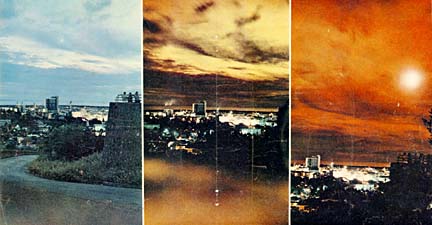
1962: Democrat John Burns elected governor; Daniel Inouye and Hiram Fong, U.S. senators; Spark Matsunaga and Thomas Gill, U.S. representatives. For first time, Democrats control both legislative houses. ALSO: After circling Earth six times, astronaut Walter Schirra plucked from ocean 1,300 miles northwest of Honolulu.
1963: Hawaii Pacific College and Hawaii Loa College founded. ALSO: President John F. Kennedy here in June for National Conference of Mayors; five months later, he is killed in Dallas.
1964: Honolulu International Center (today Neal Blaisdell Center) built.
1965: 25th Division and Hawaii-based Marines assigned to Vietnam War.
1966: U.S. Supreme Court upholds Hawaii's reapportionment plan based on registered voters instead of population. ALSO: First live TV broadcast, on KHVH.
1967: Tourism milestone: 1 million visitors in single year. ALSO: Legislature passes Land Reform Act, enabling lessees to force landowners to sell fee interests in property.
1968: Second Constitutional Convention held. ALSO: State Capitol on Beretania Street built. ALSO: Frank Fasi elected Honolulu mayor; neighbor-isle counties elect mayors for first time.
1969: Seven airlines awarded domestic routes from Hawaii to 35 mainland cities. ALSO: First moon astronauts return to Earth; USS Hornet retrieves Neil Armstrong, Michael Collins, Edwin Aldrin Jr. and their Apollo 11 craft, taking them to Pearl Harbor on July 26.
1970: Hawaii legalizes abortion -- first state to do so. ALSO: First regularly scheduled jumbo jet (747) service starts here.
1972: Milestone: 2 million annual visitors. ALSO: Hawaii is first state to ratify Equal Rights Amendment.
1973: Teachers strike for 17 days -- nation's first statewide school strike. ALSO: Hilo quake causes $1 million damage.
1974: Sugar prices soar from 11 cents a pound to 65.5 cents a pound when 40-year-old sugar act expires. ALSO: 1973 Arab oil embargo limits gasoline buying. ALSO: George Ariyoshi governor.
1975: Aloha Stadium opens. ALSO: Two killed when tsunami washes out Boy Scout camp on Big Island.
1976: Hokule'a sails to, from Tahiti, rekindling interest in Polynesian voyaging, culture. ALSO: Activists call for release of Kahoolawe from Navy test-bombing. ALSO: Honolulu Stadium razed.
1978: Third Constitutional Convention held. Among results: Office of Hawaiian Affairs created.
1979: Milestone: 4 million visitors yearly. ALSO: United Public Workers strike for some 41 days.
1982: Hurricane Iwa kills one, causes $250 million damage.
1984: Kauai's Nukolii development OK'd by Hawaii Supreme Court. ALSO: Mauna Loa, Kilauea volcanoes erupt.

1986: Honolulu astronaut Ellison Onizuka killed in shuttle Challenger explosion. ALSO: Philippines President Ferdinand Marcos deposed, flees to Hawaii exile. ALSO: John Waihee III is governor.
1991: W.M. Keck telescope starts up on Mauna Kea.
1992: Iniki, Hawaii's most destructive hurricane in recorded history, kills four, injures 1,000-plus, causes $1.6 billion in damage.
1993: Centennial of Hawaiian monarchy overthrow in January; in October, U.S. Senate apologizes to Hawaiians for illegal 1893 overthrow; in November, President Clinton signs Congressional Resolution acknowledging overthrow's illegality. ALSO: Hawaii Supreme Court rules unconstitutional the law banning same-sex marriages, unless state can justify such a ban. Appeals follow. ALSO: STARS test missile launches from Kauai's Pacific Missile Range Facility. ALSO: Dole Cannery's pineapple water tower dismantled.
1994: In May, Kahoolawe returns to state. ALSO: Federal government gives apology and redress to Japanese Americans whose Waiau properties were confiscated in WWII. ALSO: Ben Cayetano governor.
1996: Same-sex marriage debate rages in Legislature and courts; nationally, Congress passes Defense of Marriage Act. ALSO: Sugar production ends on Oahu and Big Island.
1997: Desecration of National Cemetery of the Pacific-Punchbowl and six other cemeteries. ALSO: Protests, "Broken Trust" essay spark investigations of Bishop Estate trustees. ALSO: Long-delayed, $1.3 billion H-3 Freeway opens.
1998: Voters approve constitutional amendment limiting marriage to opposite-sex couples. ALSO: UH scientists clone mice in breakthrough. ALSO: USS Missouri returns for homeport at Pearl Harbor.
1999: In November, gunman kills seven at Xerox building; worst multiple-murder case in Hawaii's recorded history. ALSO: In May, judge ousts four Bishop Estate trustees, accepts fifth's resignation. ALSO: Frank Pauline Jr. guilty, first conviction in 8-year-old Dana Ireland murder case. ALSO: 117-year-old Honolulu Star-Bulletin in legal fight to stay alive.
The Honolulu Star-Bulletin is counting down to year 2000 with this special series. Each installment will chronicle important eras in Hawaii's history, featuring a timeline of that particular period. This is the final installment. About this Series
Series Archive
Project Editor: Lucy Young-Oda
Chief Photographer:Dean Sensui